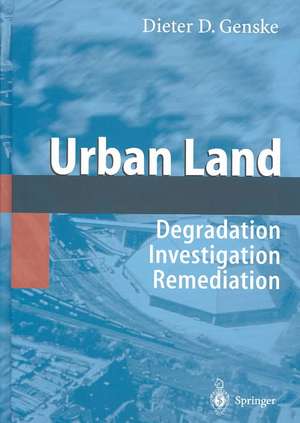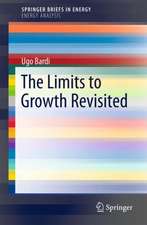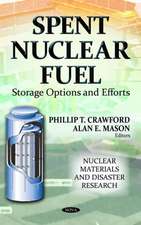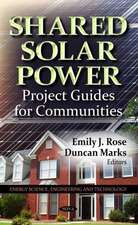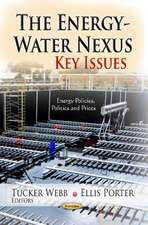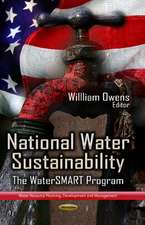Urban Land: Degradation - Investigation - Remediation
Autor Dieter D. Genskeen Limba Engleză Hardback – 13 feb 2003
| Toate formatele și edițiile | Preț | Express |
|---|---|---|
| Paperback (1) | 802.50 lei 38-44 zile | |
| Springer Berlin, Heidelberg – 17 dec 2010 | 802.50 lei 38-44 zile | |
| Hardback (1) | 959.19 lei 6-8 săpt. | |
| Springer Berlin, Heidelberg – 13 feb 2003 | 959.19 lei 6-8 săpt. |
Preț: 959.19 lei
Preț vechi: 1169.74 lei
-18% Nou
Puncte Express: 1439
Preț estimativ în valută:
183.53€ • 191.65$ • 151.56£
183.53€ • 191.65$ • 151.56£
Carte tipărită la comandă
Livrare economică 15-29 aprilie
Preluare comenzi: 021 569.72.76
Specificații
ISBN-13: 9783540438458
ISBN-10: 3540438459
Pagini: 360
Ilustrații: XVII, 336 p.
Dimensiuni: 210 x 279 x 25 mm
Greutate: 0.84 kg
Ediția:2003
Editura: Springer Berlin, Heidelberg
Colecția Springer
Locul publicării:Berlin, Heidelberg, Germany
ISBN-10: 3540438459
Pagini: 360
Ilustrații: XVII, 336 p.
Dimensiuni: 210 x 279 x 25 mm
Greutate: 0.84 kg
Ediția:2003
Editura: Springer Berlin, Heidelberg
Colecția Springer
Locul publicării:Berlin, Heidelberg, Germany
Public țintă
ResearchDescriere
Urban land is an environmental key topic considering the increasing urbani sation of our world. The amounting pressure on resources especially in the urban environment demand awareness across technical and political sectors and solid concepts for workable solutions. This book will address those people, who are key in coping with the challenges of sustainable urban land use management: Professionals in the growing field of urban land recycling and graduate students from different disciplines including urban planning, environmental sciences and geotechnics. Processes that lead to urban land degradation include the extraction of resources, their transformation into goods, the production of waste and conflicts in the allocation of land. Industrial soil pollution, soil sealing and urban sprawl pose serious challenges to resource management in urban environments. The possible implications are not necessarily restricted to the urban area but do have feedback into the countryside. The reduction of arable land in urban peripheries often causes enhanced pressure on back-country natural ecosystems such as forests, grass- and wetlands. Urban land recycling especially in the developing world is to be seen in the context of poverty alleviation and sustainable development. Ifwe don't get a proper sustainable use of urban land, as well as of water and other natural resources that relate to them, sustainable development will not be reached.
Cuprins
I Degradation.- 1 Impacts.- 2 The Impact of Producing Goods.- 3 The Impact of Disposing Waste.- 4 The Impact of Extracting Resources.- 5 The Impact of Warfare.- II Investigation.- 6 Site Investigation Strategy.- 7 Desk Study.- 8 Field Reconnaissance.- 9 Field Investigation.- III Remediation.- 10 Restoring Urban Land Versus Brownfield Aesthetics.- 11 Remediating Industrial Wasteland.- 12 Waste disposals.- 13 Remediating Sites of Resource Extraction.- 14 Remediating Sites of Warfare.- 15 Sustainable Urban Land Recycling.- References.- Appendices.- Appendix I — Tools of Statistics.- Appendix II — Contaminants in Soils.- Appendix III — Principles of Bioremediation.- Appendix IV — Subject index.- Appendix V — Locations.
Recenzii
From the reviews:
"... this is the book that we have been waiting for ... this book should grace the shelves of every public and private bureau associated with urban land use issues across Europe."
Prof. Alan Simson, The Leeds School of Art, Architecture and Design (Urban Forestry and Urban Greening 2, 2004: 173)
"In scope and content, it goes far beyond many works on this subject ... Overall it is a wide-ranging text incorporating a wealth of knowledge. Those involved with the management of contaminated land may read this text to widen their perspectives."
Prof. Stephan Jefferis, Civil Engineering Department, University of Surrey (Geotechnique2005: 341)
"Dieter Genske hopes that his textbook will stimulate discussion about sustainable use of urban land. … The volume is well presented and printed. Figures are well selected from a wide range of sources … . Overall, the book covers the wide range of material relevant to urban land in a limited space well and is worthy of examination. It is perhaps, best pitched at late-in-the course undergraduate, or graduate environmental scientists wishing to begin exploring urban land problems." (B.R.Marker, Land Degradation and Rehabilitation, Vol. 15 (6), 2004)
"There is an increasing interest in the reclamation and re-cycling of previously disturbed land. … this book is a valiant attempt to comprehensively address the issues involved. … The book benefits from some 398 figures in the text and 28 tables. It is comprehensively referenced … . this is a work of deep scholarship. … There is both a depth and breadth of knowledge … . this book should grace the shelves of every public and private bureau associated with urban land use across Europe." (Alan Simson, Urban Forestry and Urban Greening, Issue 2-3, 2004)
"... this is the book that we have been waiting for ... this book should grace the shelves of every public and private bureau associated with urban land use issues across Europe."
Prof. Alan Simson, The Leeds School of Art, Architecture and Design (Urban Forestry and Urban Greening 2, 2004: 173)
"In scope and content, it goes far beyond many works on this subject ... Overall it is a wide-ranging text incorporating a wealth of knowledge. Those involved with the management of contaminated land may read this text to widen their perspectives."
Prof. Stephan Jefferis, Civil Engineering Department, University of Surrey (Geotechnique2005: 341)
"Dieter Genske hopes that his textbook will stimulate discussion about sustainable use of urban land. … The volume is well presented and printed. Figures are well selected from a wide range of sources … . Overall, the book covers the wide range of material relevant to urban land in a limited space well and is worthy of examination. It is perhaps, best pitched at late-in-the course undergraduate, or graduate environmental scientists wishing to begin exploring urban land problems." (B.R.Marker, Land Degradation and Rehabilitation, Vol. 15 (6), 2004)
"There is an increasing interest in the reclamation and re-cycling of previously disturbed land. … this book is a valiant attempt to comprehensively address the issues involved. … The book benefits from some 398 figures in the text and 28 tables. It is comprehensively referenced … . this is a work of deep scholarship. … There is both a depth and breadth of knowledge … . this book should grace the shelves of every public and private bureau associated with urban land use across Europe." (Alan Simson, Urban Forestry and Urban Greening, Issue 2-3, 2004)
Caracteristici
All aspects of this complex subject in one volume and in systematic order with many figures, tables and examples
